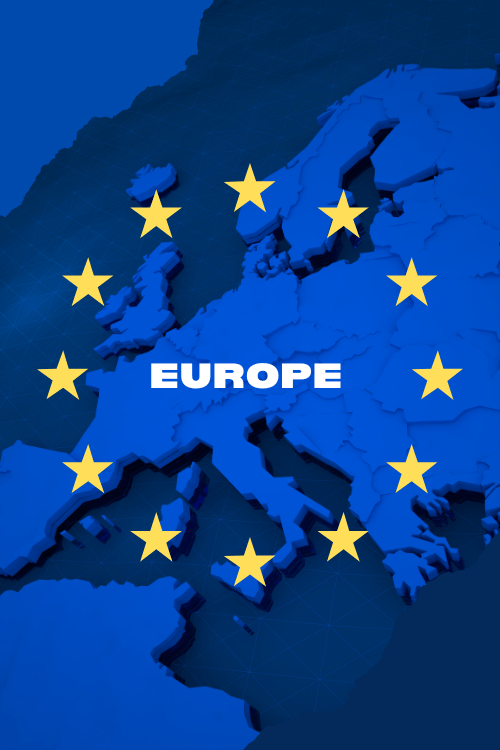eSIM Europe
What eSIM Is Best For Europe?
Planning a trip to Europe?
Staying connected while you hop between charming cities and stunning landscapes is probably high on your list.
Figuring out the best eSIM for your European adventure depends on your specific plans – how much data you need, how long you’ll be travelling, which countries you’re visiting, and your budget.
Generally, you’ll want a provider offering broad coverage across multiple European countries, flexible data packages, and a super simple setup process. Options like eSIM4 provide competitive choices. Keep reading to discover how to pick the perfect digital travel buddy for your journey. Finding the right fit means smooth sailing (and posting!).
Why an eSIM Makes Your Europe Trip Easier
Juggling SIM cards while traveling can be a pain. An eSIM, or embedded SIM, is a digital SIM card built right into your phone. It makes staying connected abroad way simpler.
Think about landing after a long flight. Instead of hunting for a SIM card kiosk or waiting in line, you can connect almost instantly. An eSIM lets you avoid those frustrating airport delays.
You also dodge potentially massive roaming charges from your home mobile provider. Using an eSIM for data can save you a surprising amount of money compared to standard international rates. This alone can make a huge difference to your travel budget.
Plus, your phone likely supports Dual SIM with an eSIM. This means you can keep your regular phone number active for calls and texts from home while using the eSIM for affordable mobile data in Europe. It’s the best of both worlds.
Need more data mid-trip? No problem. You can easily top up your eSIM plan online or through an app, often in just a few clicks. No need to find a physical store.
Some providers even offer features like auto-connection. For example, eSIM4 plans automatically connect to local networks the moment you arrive, making things even smoother.
It just works.
How To Find Your Perfect European eSIM
Choosing the “best” eSIM isn’t one-size-fits-all. It really boils down to your travel style. Let’s break down what you need to think about:
1. How Much Data Will You Actually Use?
Be honest with yourself here. How much do you typically use your phone when out and about?
- Light User: Mostly using maps, checking emails, maybe some light social media browsing? You might only need 1GB to 3GB per week.
- Medium User: Streaming music often, posting photos/videos to social media, occasional video calls? Aim for 5GB to 10GB per week.
- Heavy User: Streaming videos, working remotely, constantly uploading content, heavy hotspot use? You’ll likely need 15GB or more per week.
Think about your home usage, then add a bit extra for navigation and looking things up while exploring. Tracking your usage for a week before you leave can be insightful.
Feel free to use our eSIM Data Calculator to give you an idea of how much mobile data you’ll need for your trip.
2. Where Exactly Are You Exploring?
Europe is diverse! Are you sticking to one country or hopping around?
- Multi-Country Trips: Most travelers need a regional European eSIM. These plans typically cover dozens of countries within the EU and sometimes surrounding areas like the UK or Switzerland (always double-check coverage lists!). This is super convenient for train journeys or quick flights between nations.
- Single-Country Stays: If you’re spending your entire trip in, say, Italy, a single-country eSIM might be slightly cheaper. Compare prices, but often regional plans offer great value anyway.
- Check the Fine Print: Crucially, verify the provider’s coverage list includes every single country on your itinerary. Don’t assume!
3. How Long Will You Be Gone?
eSIM plans come with a validity period – like 7 days, 15 days, 30 days, or even longer.
- Match the plan duration to your trip length. It’s often better to get a slightly longer plan than run out early.
- Check if you can easily top up data or extend the validity if your plans change. Some providers make this easier than others. For instance, having an app to manage your plan, like the one eSIM4 offers, can be really handy for quick top-ups.
4. What’s Your Connectivity Budget?
eSIM prices can vary quite a bit.
- Compare the cost per gigabyte (GB) between different providers and plans.
- Look out for any activation fees or taxes not included in the advertised price.
- Sometimes, paying a little more might get you access to faster networks or better customer support, which can be valuable if you run into issues.
Pro Tip: Always check your phone’s eSIM compatibility before you buy anything! Most smartphones released in the last few years support eSIM, but confirming takes just a moment and saves potential headaches. Need help checking? Here’s a handy guide: How Do I Know If My Phone is eSIM Compatible?
Top eSIM Choices for Your European Travels
Okay, so what are the best eSIM Cards for Europe?
| Product | Data Allowance | Validity Period | Original Price (USD) | Current Price (USD) | Savings (USD) |
|---|---|---|---|---|---|
| Europe 500MB Pack | 500 MB | 3 Days | $5.40 | $4.20 | $1.20 |
| Europe 1GB Pack | 1 GB | 7 Days | $9.00 | $4.97 | $4.03 |
| Europe 2GB Pack | 2 GB | 15 Days | $17.10 | $13.30 | $3.80 |
| Europe 3GB Pack | 3 GB | 30 Days | $23.40 | $12.97 | $10.43 |
| Europe 5GB Pack | 5 GB | 30 Days | $36.00 | $19.97 | $16.03 |
| Europe 10GB Pack | 10 GB | 30 Days | $66.60 | $36.97 | $29.63 |
| Europe 20GB Pack | 20 GB | 30 Days | $88.20 | $68.60 | $19.60 |
| Europe 50GB Pack (30 Days) | 50 GB | 30 Days | $144.00 | $99.97 | $44.03 |
| Europe 50GB Pack (90 Days) | 50 GB | 90 Days | $180.00 | $140.00 | $40.00 |
| Europe 100GB Pack | 100 GB | 180 Days | $333.00 | $259.00 | $74.00 |
See all of these eSIM data packs here.
The best approach? Identify your needs (data, days, countries) and then compare 2-3 providers that seem like a good fit based on coverage and price.
eSIM vs. Physical SIM: Making the Call for Europe
Is an eSIM always better than a traditional plastic SIM card? Not necessarily, but for most European trips, it offers significant advantages. Let’s compare:
Why Choose an eSIM?
- Instant Gratification: Buy it online anytime, get it delivered via email or app instantly. No waiting for shipping or store visits.
- Keep Your Home SIM Safe: No need to physically remove your primary SIM card. Reduces the risk of losing that tiny, important piece of plastic.
- Digital Flexibility: Easily switch between different eSIM plans or providers without needing a new physical card.
- Travel-Focused Plans: eSIM providers often specialize in short-term travel plans that are perfect for vacationers. Want to know more about the direct comparison? Check out: Is eSIM Better Than SIM?
- Eco-Friendly: No plastic waste or packaging.
Potential eSIM Downsides:
- Device Dependency: Your phone must be eSIM compatible. Older models or some budget phones might not support it. Even some newer models might have limitations, for example, check out specific device guides if unsure: Does iPhone SE 3rd Gen Have eSIM?
- Setup (Slight Learning Curve): While usually easy (scanning a QR code), it’s a different process than popping in a physical SIM. Doing it for the first time might feel a tiny bit unfamiliar.
- Phone Issues Abroad: If your phone breaks and you need a replacement, transferring an eSIM might be more complex than just moving a physical SIM.
Why Stick with a Physical SIM?
- Universal Compatibility: Works in virtually any unlocked phone. No need to check compatibility lists.
- Easy Swapping: If you need to use a different phone temporarily, just move the SIM card.
- Familiarity: It’s the process most people are used to.
Physical SIM Downsides:
- Acquisition Hassle: You need to buy it physically – either order ahead (wait for shipping) or find a store upon arrival (time-consuming, language barriers).
- Risk of Loss: You have to remove and store your home SIM. Losing it is a common and frustrating travel mishap.
- Less Online Flexibility: Topping up or changing plans usually requires visiting a store or navigating potentially tricky local provider websites.
- Needs a Tool: Requires a SIM eject tool, which is easy to misplace.
The Verdict for Your Trip?
- Multi-country Europe trip + compatible phone? An eSIM is almost certainly your most convenient and flexible option.
- Long stay in one country? Compare eSIM prices with local physical SIM deals. Sometimes a local plan offers more data for less if you’re staying put for weeks/months.
- Older/incompatible phone or prefer the old way? A physical SIM procured upon arrival is still a workable solution.
“Imagine landing in Rome, switching off airplane mode, and immediately being able to pull up directions to your hotel or message family back home. No frantic search for airport WiFi, no confusing SIM vendor interactions. That’s the peace of mind an eSIM offers.”
Activating Your European eSIM: Simpler Than You Think
Getting your eSIM working is usually straightforward. Here’s the typical process:
- Purchase: Choose your plan and buy it online.
- Receive: You’ll get activation details via email, often including a QR code or an installation link/button if using the provider’s app. eSIM4, for example, emails your QR code right after purchase.
- Install (Needs Wi-Fi!): Before you lose connection (at home before leaving, or using airport/hotel Wi-Fi upon arrival), go into your phone’s settings (usually under Cellular/Mobile Data > Add eSIM/Data Plan). Scan the QR code or follow the provider’s specific link/app instructions.
- Label It: Your phone will prompt you to label the new eSIM. Choose something clear like “Europe Travel” or “Holiday Data”.
- Configure: Set the eSIM for Mobile Data. Decide if you want it to be your default voice line (usually you’ll keep your home SIM for that).
- Enable Roaming (for the eSIM ONLY): This is key! Go into the settings for your newly added eSIM and make sure Data Roaming is turned ON. At the same time, double-check that Data Roaming is turned OFF for your home SIM to avoid charges.
Follow the specific steps provided by your eSIM company, as there might be slight variations.
It usually only takes a few minutes.
- Quick Checklist Before You Buy:
- Is my phone unlocked and definitely eSIM compatible?
- Does the plan cover all European countries I’m visiting?
- Is the data amount (GB) and validity period (days) sufficient?
- Have I quickly compared price and features from 2-3 providers?
Dodge These Common eSIM Mistakes in Europe
Using an eSIM is generally smooth, but a few hiccups can occur. Here’s how to avoid them:
- Activating Too Soon: Most travel eSIMs activate when they first connect to a network in the destination country. Don’t install and try to fully activate it weeks before your trip unless the provider specifically tells you to. Install it maybe a day before you leave or upon arrival using Wi-Fi.
- Forgetting eSIM Data Roaming: This is the most common issue! You must enable Data Roaming in your phone settings specifically for your travel eSIM profile. Keep roaming OFF for your home SIM. Seriously, double-check this.
- No Wi-Fi for Setup: Remember you need an internet connection (Wi-Fi) to scan the QR code and download the eSIM profile to your phone initially. Plan accordingly.
- Manual Network Issues: Let your phone automatically select the network first. Only manually choose one if you’re having persistent connection problems and know which local network partners your eSIM provider uses.
- Running Out of Juice (Data!): Keep an eye on your data usage. Most provider apps or websites let you track it. If you’re running low, top up before you run out completely, especially if you rely on data for navigation. Choosing a provider with easy top-ups is a lifesaver.
Your Seamlessly Connected European Adventure Starts Now
So, what’s the final word on the best eSIM for Europe? It’s the one that perfectly matches your unique travel needs.
Focus on providers offering reliable coverage across the countries you’ll visit, with data amounts and validity periods that fit your trip. Compare a few options based on price per GB and essential features like ease of setup and top-up.
Using an eSIM transforms how you connect abroad. It means less stress, more spontaneous exploring, instant sharing of your amazing moments, and potentially significant savings compared to roaming fees. Your European trip is about making memories, not wrestling with connectivity issues.
Do a little research based on what we’ve discussed, pick your plan, and get ready for a smoother, more connected journey through Europe.







